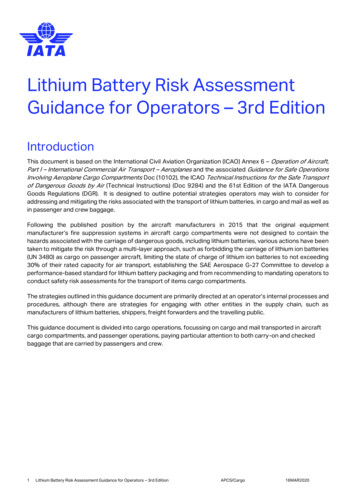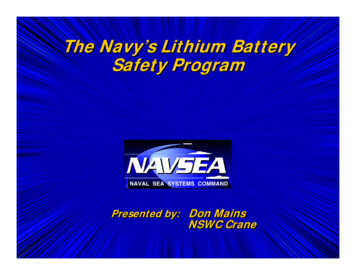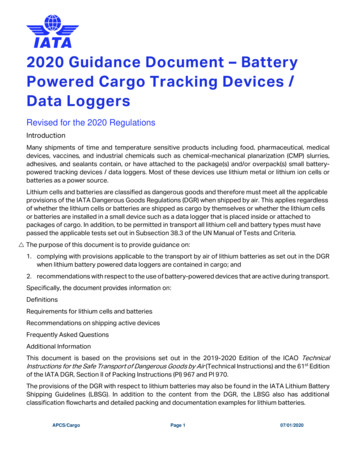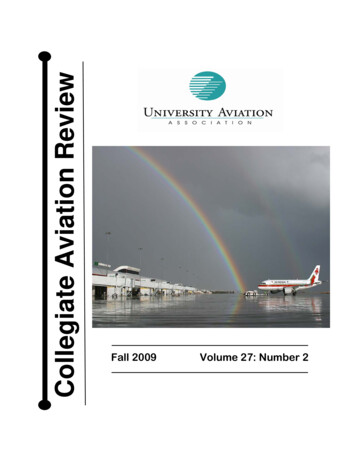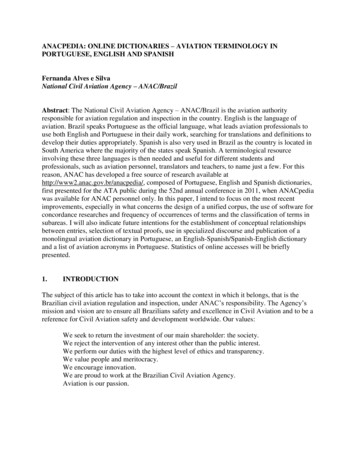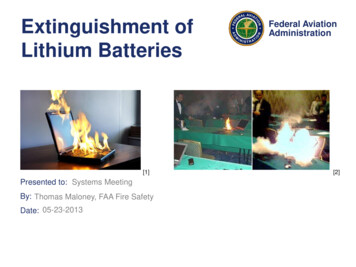
Transcription
Extinguishment ofLithium Batteries[1]Presented to: Systems MeetingBy: Thomas Maloney, FAA Fire SafetyDate: 05-23-2013Federal AviationAdministration[2]
Background Growth in Lithium Battery Use– The number of lithium-ion batteries made in the world grewfrom about 800 million in 2002 to about 4.4 billion in 2012. [3] Fire Risk– Many lithium ion cells have been known to overheat and createa potentially dangerous situation. Extinguishing Agents– Many extinguishing agents are suggested for use againstlithium-ion battery fires but there is little data comparing thecooling effectiveness of various agents.Extinguishing Agents for Lithium-ion Batteries05-23-13Federal AviationAdministration22
Introduction Thermal Runaway– A self reinforcing exothermic reaction resulting in very hightemperature and pressure within the cell resulting in therelease of flammable electrolyte or explosion.– A cell in thermal runaway generates enough heat to causeadjacent cells to go into thermal runaway, propagatingthroughout the battery pack or shipment. Extinguishing Agents– Extinguishing agents that cool the cells will decrease thelikelihood of propagation of thermal runaway.Extinguishing Agents for Lithium-ion Batteries05-23-13Federal AviationAdministration33
Related Tests FAA– Tests done at the FAA showed that water was effective atextinguishing burning electrolyte from lithium-ion cells as well asstopping the propagation of thermal runaway.– Halon 1211 was effective in extinguishing burning electrolyte fromlithium-ion cells, but was ineffective in stopping the propagation ofthermal runaway.– Halon 1301 was also effective in extinguishing burning electrolytefrom lithium-ion cells, but was ineffective in stopping the propagationof thermal runaway.– Ice was not effective at preventing thermal runaway when placeddirectly on a laptop keyboard.Extinguishing Agents for Lithium-ion Batteries05-23-13Federal AviationAdministration44
Objective Perform experiments to compare thecooling effectiveness of variousextinguishing agents.Extinguishing Agents for Lithium-ion Batteries05-23-13Federal AviationAdministration55
Setup and ProcedureAgent TargetExtinguishing Agents for Lithium-ion Batteries05-23-13Federal AviationAdministration66
Setup and Procedure (continued) Extinguishing agents were poured onto the plate andpoured from an extinguisher.– Poured: Water, Aqueous A-B-D Agent, Novec 1230, AF-31, AF-21– Sprayed: FM-200, FE-36, Purple-K, Halon 1211, Halotron I The temperature drop was determined by𝑻𝒅 𝑻𝒊 𝑻𝟏𝟎𝟎where: 𝑻𝒅 average temperature drop𝑻𝒊 The temperature immediately before agent release𝑻𝟏𝟎𝟎 The average temperature for the 100 seconds following agent releaseExtinguishing Agents for Lithium-ion Batteries05-23-13Federal AviationAdministration77
ResultsExtinguishing Agents for Lithium-ion Batteries05-23-13Federal AviationAdministration88
Results (continued)WaterAqueous AB-D AgentNovec1230Halon1211FM-200Halotron IFE-36Purple-KAF-31 25%(aqueous)AF-21(aqueous)Extinguishing Agents for Lithium-ion Batteries05-23-13Federal AviationAdministration99
Summary of Results Under these test conditions, the aqueousagents exhibited the highest coolingeffectiveness. Increasing the volume of the aqueousagents resulted in higher temperaturereductions. The non-aqueous agents exhibited littlecooling capacity and showed minimalincrease in effectiveness with greatervolumes.Extinguishing Agents for Lithium-ion Batteries05-23-13Federal AviationAdministration1010
Future Work Demonstrate the effectiveness of eachagent on a simulated laptop lithium-ionbattery fire– Extinguish the electrolyte fire– Stop the propagation of thermal runaway Repeat with lithium metal cellsExtinguishing Agents for Lithium-ion Batteries05-23-13Federal AviationAdministration1111
Questions? Contact– Thomas Maloney– Office: 609-485-7542– Thomas.ctr.Maloney@faa.govExtinguishing Agents for Lithium-ion Batteries05-23-13Federal AviationAdministration1212
Citations [1] http://oxford.tab.co.uk/files/2013/03/laptop2.jpg [2] eries-and-fire-safety.html [3] ing Agents for Lithium-ion Batteries05-23-13Federal AviationAdministration1313
-The number of lithium-ion batteries made in the world grew from about 800 million in 2002 to about 4.4 billion in 2012. Fire Risk -Many lithium ion cells have been known to overheat and create a potentially dangerous situation. Extinguishing Agents -Many extinguishing agents are suggested for use against
